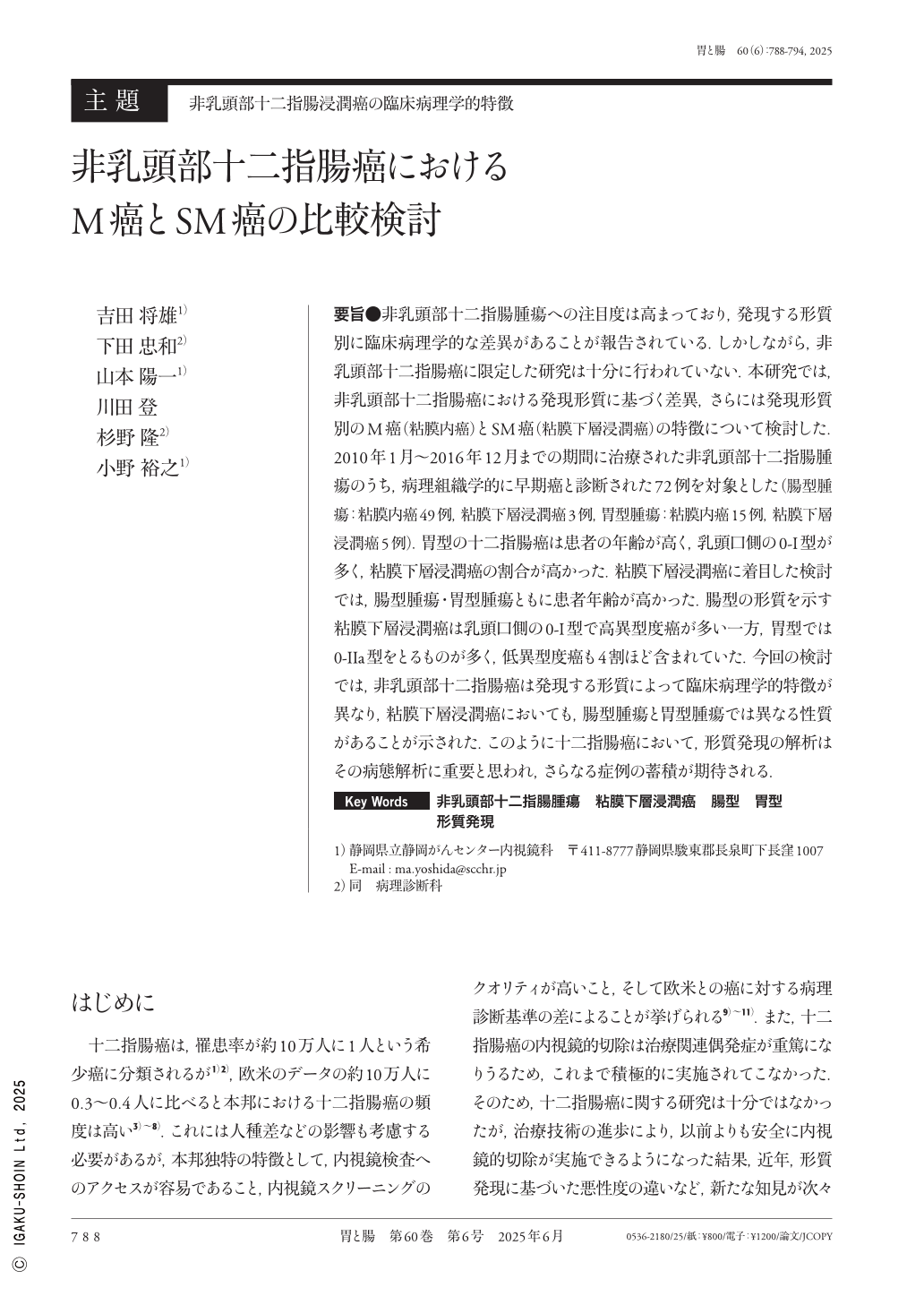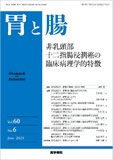Japanese
English
- 有料閲覧
- Abstract 文献概要
- 1ページ目 Look Inside
- 参考文献 Reference
要旨●非乳頭部十二指腸腫瘍への注目度は高まっており,発現する形質別に臨床病理学的な差異があることが報告されている.しかしながら,非乳頭部十二指腸癌に限定した研究は十分に行われていない.本研究では,非乳頭部十二指腸癌における発現形質に基づく差異,さらには発現形質別のM癌(粘膜内癌)とSM癌(粘膜下層浸潤癌)の特徴について検討した.2010年1月〜2016年12月までの期間に治療された非乳頭部十二指腸腫瘍のうち,病理組織学的に早期癌と診断された72例を対象とした(腸型腫瘍:粘膜内癌49例,粘膜下層浸潤癌3例,胃型腫瘍:粘膜内癌15例,粘膜下層浸潤癌5例).胃型の十二指腸癌は患者の年齢が高く,乳頭口側の0-I型が多く,粘膜下層浸潤癌の割合が高かった.粘膜下層浸潤癌に着目した検討では,腸型腫瘍・胃型腫瘍ともに患者年齢が高かった.腸型の形質を示す粘膜下層浸潤癌は乳頭口側の0-I型で高異型度癌が多い一方,胃型では0-IIa型をとるものが多く,低異型度癌も4割ほど含まれていた.今回の検討では,非乳頭部十二指腸癌は発現する形質によって臨床病理学的特徴が異なり,粘膜下層浸潤癌においても,腸型腫瘍と胃型腫瘍では異なる性質があることが示された.このように十二指腸癌において,形質発現の解析はその病態解析に重要と思われ,さらなる症例の蓄積が期待される.
Although interest in non-ampullary duodenal cancer has grown in recent years, limited research has addressed the progression from mucosal carcinoma to submucosal invasive carcinoma. In this study, we investigated the clinicopathological characteristics of both mucosal and submucosal invasive carcinomas in non-ampullary duodenal cancer, with particular attention to mucin expression phenotypes. A total of 72 cases of superficial non-ampullary duodenal cancer treated between January 2010 and December 2016 were retrospectively analyzed. These cases were classified based on mucin phenotype into intestinal-type and gastric-type tumors. Among the intestinal-type cases, there were 49 intramucosal and three submucosal invasive carcinomas. For the gastric-type, 15 intramucosal and five submucosal invasive carcinomas were identified. Gastric-type tumors were significantly associated with older patient age, a predominance of type 0-I lesions located on the oral side of the papilla, and a higher frequency of submucosal invasion compared with intestinal-type tumors. When analyzing only submucosal invasive carcinomas, both types were more commonly observed in older patients. Intestinal-type submucosal invasive carcinomas frequently presented as type 0-I lesions with high-grade atypia, predominantly located on the oral side of the papilla. In contrast, gastric-type submucosal invasive carcinomas were more commonly of the 0-IIa type, and approximately 40% of these exhibited low-grade atypia. These findings indicate that non-ampullary duodenal carcinomas differ significantly in their clinicopathological characteristics depending on their mucin phenotype. Even among submucosal invasive lesions, intestinal- and gastric-type tumors display distinct biological behaviors. Therefore, phenotypic classification based on mucin expression is essential for a more comprehensive understanding of the pathogenesis of non-ampullary duodenal carcinoma. Continued accumulation and analysis of case data are warranted to further clarify these differences.

Copyright © 2025, Igaku-Shoin Ltd. All rights reserved.


